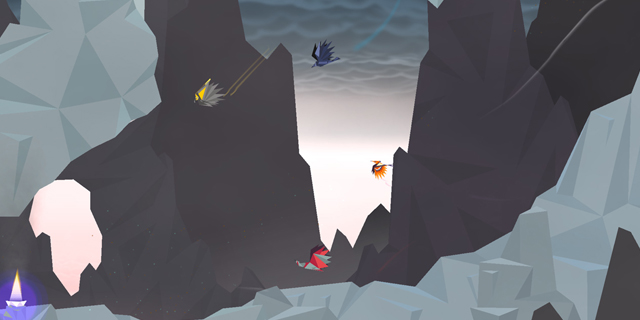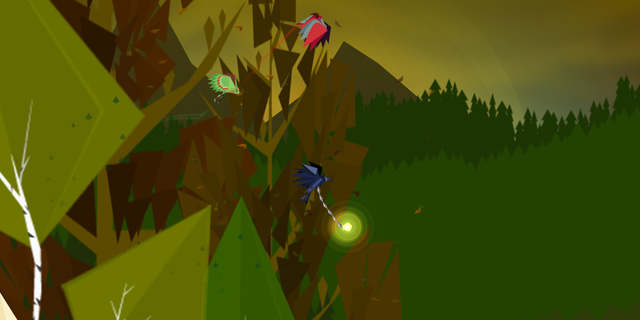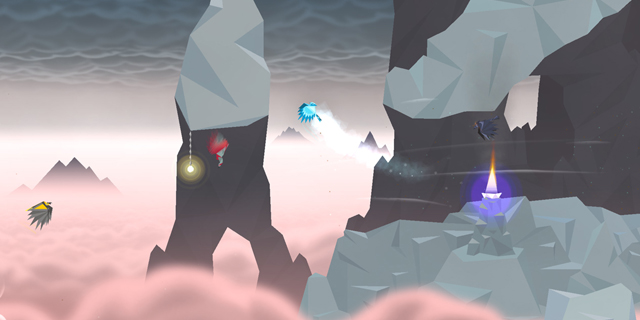
There may not be a game yet available for the Wii U that can best the thoughtful, cohesive aesthetic of Chasing Aurora. The eShop exclusive from Broken Rules doesn’t exactly push the system’s horsepower, but everything, from the ambient soundtrack to the differently-scaled TV and GamePad interfaces to the look of the levels, is exactly what it needs to be. For all the game’s missteps (and there are a few), it maintains a wholly pleasant feel throughout.
In Chasing Aurora, you control a bird, flapping around and diving using a distinct control scheme that only makes sense with the feathered creatures. There are a few different game types, but each takes place in a 2D map, each tailored to evoke a different climate and level of cover. Flapping isn’t a pure mash-fest, as timing your presses appropriately alows for the most speed and the smoothest gliding. Diving is way faster, as it should be, so much of the nuance of control stems from maintaining the ideal height or taking advantage of the discrepancy to your own benefit.

The single-player portion of the game is nothing special, and serves to train you in the ways of the wing. It consists of a series of timed courses, and the goal is to make laps around the course as fast as possible. It’s relatively easy to just do your best and keep moving to the next one, so it takes a certain tenacity to go back and try to improve. There are 20 levels, though, and you can definitely just let a certain peace wash over you and enjoy each one.
The multiplayer is largely the reason for the game’s existence, though, and the reason it’s on Nintendo’s new platform. There are a few different variations to the gameplay, but each lets you take control of one of the game’s five colored birds and chase (or run away from) the others. Chase is the simplest and, often, the most enjoyable. One bird’s holding an orb on a string. The rest try to fly between the orb and the bird to take the orb, while the orb-wielder is trying to get the other birds off the screen to score points.

Hide and Seek gives the GamePad player the orb, and tasks the other split-screen players with tracking the orb-holding bird down. There are places to seek cover, but a glowing orb makes that a bit tough; it’s more likely that a pursuer uses it to lie in wait. Freeze Tag makes the GamePad bird able to freeze the others by touching them; the goal is to freeze everyone, and any unfrozen birds can touch a frozen one to revive it. (Of course, that puts you out in the open where you can be tagged.)
These game types are strung together into tournaments, and this is where Chasing Aurora falls flat a bit. Each round, a different player is switched onto the GamePad. This is crucial, since each game starts that player with the orb and, as such, generally gives them more points. With such a focus on five-player play, it’s strange that so many of the tournaments are for fewer rounds; unless you play a number equal to your participants, the scoring just isn’t going to be fair, as it becomes incredibly difficult for a TV-only player to overcome that deficit. There’s a random tournament function, so you can keep generating until you find one you need, which should fix it. Not quite, though.
Why? These also generate random game types, and a round of Chase tends to have much more even scoring than, say, a round of Hide and Seek. If you hold the GamePad for Hide and Seek, you can regularly come away with 80% or more of the round’s points. It’s more like a 45-20-15-10-10 split for your average other round, and this tends not to change with skill as the advantage still lies with the one with the head start.
If you can make sure to have the exact ideal experience with Chasing Aurora: that is, a five-player, five-round, one-game-type session, it can be very fun. The controls are super-slick, and even the simple little birds have a lot of personality. It may not be enough for everyone if a game can’t be endorsed without caveats. If you do pick it up, though, you’ll like the view.
Pros: Wonderful aesthetics, smooth controls
Cons: Lacking single-player, unbalanced scoring



















